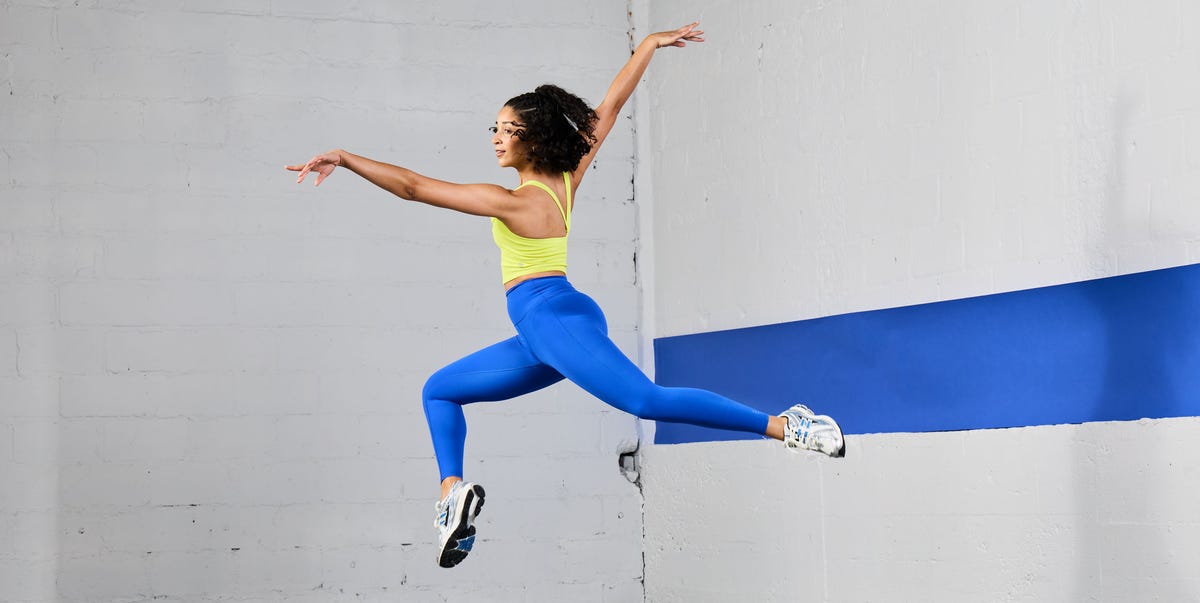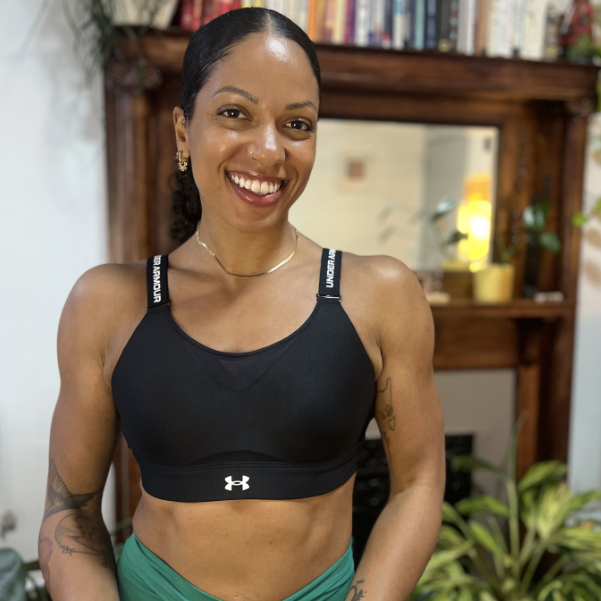If lately your workouts feel a little too…grounded, it might be time to take things airborne. Bungee workouts—a high-energy, low-impact fitness class where you leap, float, and plank while strapped into a bungee harness—are popping up in fitness studios across the country. (Even Timothée Chalamet gave it a go in a recent SNL skit.)
“Bungee fitness is a low-impact, high-resistance cardio workout,” says Callie Thornton, a bungee studio owner and founder. With the help of bungee cords, you’ll flow through a mix of dance, strength, and cardio moves—all while feeling like you’re moving through the air. The cords act as built-in support, absorbing impact so your joints don’t take a beating, she adds.
Meet the experts: Callie Thornton is a bungee studio owner and founder of The Fly Witches in Kentucky. Melanie Taylor is the owner of the bungee studio PH Fit in North Carolina. Jaclyn Kolianos is the owner and CEO of Fly Bungee Fitness in Ohio. Aly Beck, DPT, is an Orthopedic and Pelvic Health Physical Therapist at Nashville Physical Therapy and Performance in Tennessee. Molly Frankinburger, PT, DPT, CSCS, is a physical therapist at Hospital for Special Surgery (HSS) in New York City.
Ahead, bungee fitness pros break down the benefits, who should try it, and what to expect in your first class.
What is a bungee workout, exactly?
Bungee workouts consist of moves like squats, jumping jacks, and even burpees while wearing a fitted harness attaching you to the ceiling via bungee cords. Early iterations of the workout reportedly emerged at Stories to Tales Theatre in Bangkok, Thailand around 2016, but hit the United States around 2017, says Melanie Taylor, who opened her bungee studio PH Fit in North Carolina that year. Now, bungee fitness classes seem to be everywhere, from St. Augustine, Florida, to London, Munich, and Mexico City.
Bungee workouts offer high resistance with minimal impact. You can work against the bungee cord’s resistance for more intensity—think of stretching a rubber band—or with it, to make things less intense, like snapping a rubber band back. Adjusting your body position—moving farther or closer to the anchor point—lets you easily increase or decrease resistance to accommodate your strength level.
Just like your Pilates studio might offer a variety of classes that emphasize different moves, intensities, or muscle groups, bungee workout classes also vary in style, including full-body classes, fly intensives (more on that in a sec), and cardio bootcamps. But while the classes may range in focus, bungee workouts are generally built off of six foundational moves, says Jaclyn Kolianos, a bungee studio owner and CEO of Fly Bungee Fitness.
1. Squats: In a bungee squat, you sit back as if reaching for a chair to emphasize the glutes, Kolianos says.
2. Running: This move will warm up and familiarize your body with being connected to bungees. In the running exercise, you’ll jog away from the bungee cord’s center mount, enabling the cords to absorb some of your impact while also putting resistance on your body so it works harder, Kolianos says.
3. Jumping jacks: These are somewhat like the bodyweight version, but “the bungee cords take the impact off,” says Thornton. Because you don’t land with your full body weight, your legs won’t hit the ground as hard.
4. Burpees: This move is broken into four parts, Kolianos says: First, you squat, then using the assistance of the bungee cords, kick your feet out to land in a supported plank position, then spring back into a squat, and return to standing.
5. Plunges: A plunge is essentially a trust fall—with your bungee, says Kolianos. Using your core and glute muscles, you’ll hold strong posture as you fall toward the floor in the plank position, “tap the floor and squeeze everything to come back up,” she says.
6. Knee flies: You’ve probably seen these Peter Pan- or Tinkerbell-like moves on TikTok. In these, you run and jump into the air, pulling one of your legs into your upper thigh like the yoga Tree Pose as you fly.
5 Benefits Of Bungee Workouts
1. They are easy on your joints.
Because the bungee cords offload some impact, they can be ideal for folks returning to exercise, or just getting into it. “Bungee workouts could be a great option for someone with joint pain, someone returning from a lower body overuse injury like a stress fracture, or returning to exercise after surgery or immobilization,” says Aly Beck, DPT, an orthopedic physical therapist.
Since the bungee cords reduce the impact on the joints, folks with knee or back issues might also benefit from trying the workout, adds Molly Frankinburger, PT, DPT, CSCS, a physical therapist. (Of course, if you’re recovering from surgery or any other type of injury, your medical provider should give you the go-ahead before you try bungee classes.) “Several clients have told us they haven’t been able to do jumping jacks or squat jumps until they got on the bungee because of their hips and knees,” and the low-impact nature of the workout was perfect, says Taylor.
With the low-impact design of bungee classes, these workouts are accessible to a range of fitness levels and abilities, and can be optimal for aging or senior athletes. Both Thornton and Kolianos say folks over 50 enjoy their classes.
2. They can boost your cardio fitness.
“The dynamic movements elevate the heart rate, improving endurance and cardiovascular health,” says Frankinburger. “Bungee workouts promote continuous movement, similar to HIIT workouts,” which are especially successful in improving cardio fitness, per 2021 research in the International Journal of Environmental Research and Public Health. But this untraditional form of cardio can feel way more fun and engaging if you’re stuck in a cardio machine rut. They’re also a great swap for those who might not enjoy running or the elliptical, Taylor adds.
Plus, exercise has shown to strengthen the heart muscle and subsequently lower blood pressure, according to 2022 research in Frontiers in Sports and Active Living. (Kolianos shared that some of her older clients reported lower blood pressure after regularly attending classes at her studio.)
3. They are a full-body workout.
As you leap, bound, jog, and burpee your way throughout a bungee workout class—moves that work the full body—your muscles have to work in harmony to properly execute each move. You might take more beginner-friendly total-body classes to start, then move on to more specialized classes that isolate muscle groups like the core and arms, Thornton says. But regardless, since you’re on your feet during pretty much an entire class, bungee workouts always “engage the core, legs, and upper body muscles while improving balance and coordination,” Frankinburger says.
4. They can help improve coordination.
Did you know that, as your brain becomes familiar with performing a task, it requires less focus to complete it? (When you brush your teeth, you probably don’t have to instruct your hand to actually hold your toothbrush.) “Activities that challenge coordination, use repetition, and allow us to move in new or different ways can be great for our brains and nervous systems as we age,” says Beck. General exercise has been found to reduce the threat of cognitive decline including memory loss in older adults, per 2020 research in the Journal of Cerebral Blood Flow & Metabolism.
5. They may help improve mood.
While it’s always best to check in with a licensed professional if you’re struggling with your mental health, attending group fitness classes has been found to improve mental wellbeing by lowering stress levels. “Having fun, doing something we enjoy, and connecting or being in community with others is great for our mental health,” says Beck.
4 Potential Risks And Considerations Of Bungee Workouts
As with any new type of workout, it’s important to ensure that the workout is right for you and your current fitness level before signing up for your first class. While bungee workout classes offer plenty of benefits, they still might not be right for everyone. (If you’re unsure, ask your doctor if bungee classes are okay for you.)
Here are some risks and considerations of bungee workouts:
1. They might trigger vertigo.
If you’re susceptible to motion sickness or vertigo, Beck and Frankinburger say that these classes might not be the best option. “If you’re prone to dizziness, vertigo, or have blood pressure issues, there’s a potential risk of triggering an episode with fast movements that change direction,” like burpees, says Beck.
2. They may exacerbate certain back issues and injuries.
As the harness is placed around your lower back, some folks with injuries in this area might want to skip these workouts. “While bungee workouts are low impact, they still involve dynamic movements,” Frankinburger says. “People with chronic back pain due to severe arthritis or herniated discs should be careful.”
3. They may spark the heart rate, which can be dangerous for folks with certain heart conditions.
Increasing your heart rate through aerobic exercise can be beneficial for lowering blood pressure, per 2023 research in the British Journal of Sports Medicine. However, if you have high blood pressure, check in with your doctor before heading to bungee class. “The high intensity of bungee workouts can cause sudden spikes in heart rate, which may be risky for those with cardiovascular issues such as high blood pressure,” says Frankinburger.
If you have high blood pressure, make sure your doctor clears you for bungee class. Then, consider wearing a heart rate monitor and keep an eye on your heart rate zones to stay safe during the workout, Thornton adds.
4. They aren’t advised for pregnant people.
Bungee workouts require you to wear a harness around your legs, stomach, and butt, which may not be advisable for those who are pregnant. “The harness places pressure on the abdomen and lower back, which could be uncomfortable or unsafe during pregnancy,” says Frankinburger. (Some studios don’t even permit pregnant folks to participate in classes for safety reasons, Thornton and Kolianos say.) However, if you did bungee workouts before you got pregnant, you may be okay to continue, depending on your OB-GYN’s guidance, Becks says.
How To Incorporate Bungee Workouts Into Your Fitness Regimen
Bungee classes should be part of a comprehensive fitness routine. While low-impact exercises can offer plenty of benefits, Beck points out that they might be most successful in a comprehensive workout regime that includes functional fitness, like resistance training.
“These workouts should not replace regular resistance training workouts as you’re not fully weight-bearing, so you won’t likely be providing enough of a stimulus to improve or maintain muscle mass or bone density,” she says. “Depending on how challenging the class is, it may be a good option for moderate-high intensity interval cardio work, but that would very much depend on the pace of the class and the individual.”
“Most people should focus on prioritizing moderate-heavy strength training two to four times per week, and at least 150 minutes of moderate-intensity cardio per week,” says Beck. (Or do 75 minutes of high intensity activity each week, as the CDC recommends.) And try not to skimp on your mobility and stretching. As for your bungee workouts, consider adding “one to two bungee workouts each week for fun, or as part of your cardio training,” she says.
How To Find A Bungee Workout Studio Near You
To find a class, try searching platforms like ClassPass or MindBody. But while bungee workouts are growing more popular, they’re still not as common as, say, cycling or yoga classes. So, if you can’t find a studio near you, it is possible to try bungee workout classes at home with apps like Fly High Bungee Fitness feature Kolianos’ classes and workout replays.
However, you’ll need to invest in a full setup including a harness, bungee cords, swivels, daisy chains, mounts, and other key pieces of equipment. You’ll also need to work with a structural engineer to ensure that your ceiling is structurally sound and high enough to support you during the workout.
What To Expect In Your First Class
While every studio approaches their class structure a little differently, most require newbies to join a beginner class, which can range from 30 minutes to an hour. First, an instructor will fit you in a harness, which should feel snug, Thornton says. So, if your harness butt is a little saggy when doing a squat, have your instructor double check the fit.
To kick off the class, your instructor will likely introduce the proper technique of the foundational moves, Kolianos says. Once you’ve got your blood moving, the instructor may progress the class to include more complex moves like burpees, which might be interspersed with dance-inspired choreography to help you score a solid cardio workout. No matter if you’re a seasoned pro or newcomer, Thornton says it’s important to listen to your body and take breaks as needed.
A day or two after class, you might feel sore, especially in your groin and inner thigh area, Thornton says. Newcomers usually aren’t familiar with wearing a harness, so it can cause some minor discomfort. If you’re feeling any debilitating pain or pain that persists beyond standard muscle soreness, err on the side of caution and check in with your licensed medical provider. If your doctor clears you for another class, chat with your instructor ahead of time about your soreness and have them take a peek at your harness’s fit before you start moving.
What To Wear
The instructors recommend wearing clothing that covers your stomach, waist, and thighs, like leggings or full-length workout tops (with a high-impact sports bra underneath) that are on the tighter side. (Skip the crop tops and running shorts, since harnesses can rub bare skin!) Also, since shoe policies can vary—some studios prefer you to wear sneakers and others suggest using bare feet—be sure to check if the studio requires sneakers.
There’s no doubt that bungee classes are a blast with their bountiful benefits and fun-loving atmosphere. Whether you’ve always had dreams of flying like Tinkerbell or you’re searching for a different workout to shake up your routine, bungee workouts can introduce you to a vibrant community set on having a good time while you sweat.

Liz Doupnik is a freelance culture and lifestyle journalist based in Nashville, TN who writes about books, fashion, and wellness. With nearly 20 years of experience, Liz cut her teeth working as a full-time editor at WWD, StyleCaster, and Seventeen, and has led editorial teams at SHAPE and Nike. A lifelong athlete, Liz has also worked as a certified personal trainer and obtained her Master Training certification from Focus Personal Training Institute. As a freelancer, her work has appeared in W, Marie Claire, Dwell, Teen Vogue, Well & Good, The Zoe Report, and many others. When she’s not busy at work, you can find her logging a long run on one of Nashville’s many trails, perusing the shelves at her favorite local bookstore, or searching for her future rescue pup.
Read the full article here





